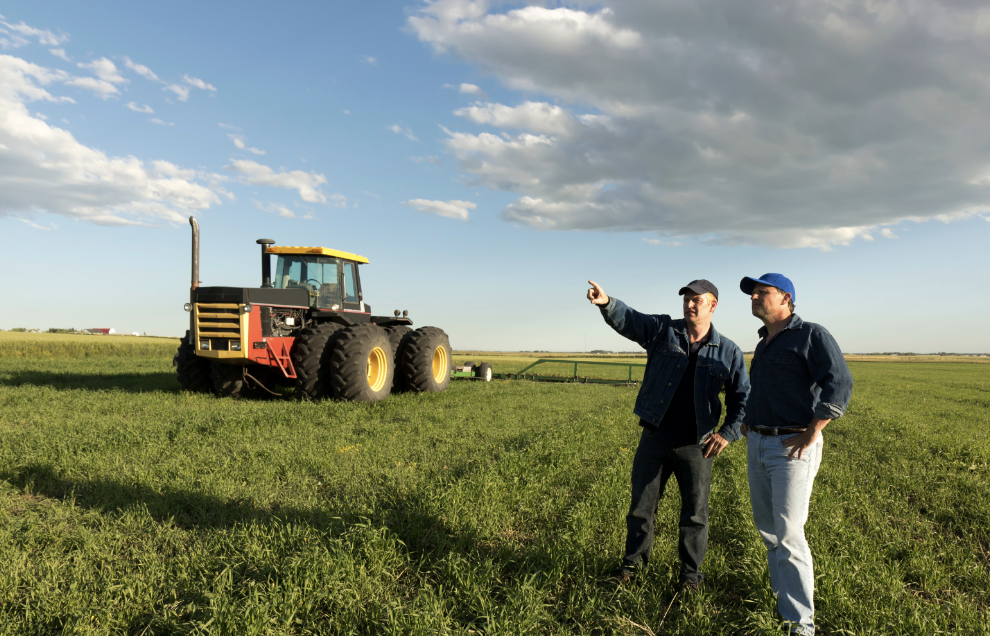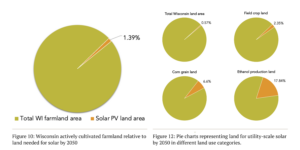Solar fields can supply abundant, clean electricity – almost one-third of Wisconsin’s consumption by 2050 – using only a small portion of the state’s agricultural land. Nonetheless, solar energy development in agricultural areas raises new discussions of land use in Wisconsin. A recent report explores Wisconsin’s agricultural trends and outlines the potential solar energy has to sustain the state’s agricultural heritage, keep Wisconsin farmers in business, and provide environmental and economic benefits to the greater public. This blog will summarize the report’s findings and discuss the implications of solar energy development on land use for farmers in Wisconsin.
Wisconsin’s changing agricultural landscape
Wisconsin’s agricultural economy has changed substantially over the last several decades due to technological advancements, improved farm practices, evolving market conditions, and other macroeconomic trends. Data from the USDA National Agricultural Statistics Service shows that the amount of actively cultivated farmland has decreased by 23% since 1982, alongside the number of farm operations (from 90,000 to 64,100 in 2022).
At the same time, due to advancements in practices and technology, corn and soybean yields have increased dramatically (69% for corn and 75% for soybeans). However, the market’s oversupply has caused inflation-adjusted prices for corn to gradually decrease since 1909. Real prices for corn in 2022 are 51% lower than in 1940 and 42% lower than in 1980. Commodity price volatility has also added financial uncertainty for farmers, with farmers experiencing large annual swings in the prices received for corn. The downward trend in real prices and constant volatility in nominal prices shows why corn producers and other Wisconsin farmers face growing pressure to scale up their operations or sell their land.
Enrollment in the USDA’s Conservation Reserve Program (CRP), an ecosystem services program aimed at improving soil health and managing the oversupply of crops, has been decreasing since the early 2000s in Wisconsin. However, about 200,000 acres of voluntarily retired farmland under the CRP in the state is planted with ground covers such as grasses, trees, and native plants in exchange for an annual payment from the federal government.
Achieving a net-zero economy in Wisconsin with solar energy
Recent trends have allowed farmers to incorporate solar developments into a portion of their property and, at the same time, continue farming and sustaining their agricultural businesses. Solar fields offer stable revenue streams for Wisconsin farmers and financial support to local governments through the state’s shared revenue formula. RENEW Wisconsin’s collaborative report, Achieving 100% Clean Energy in Wisconsin (100% Clean Energy Report), shows that solar development opportunities will grow for Wisconsin farmers over the next few decades. According to the report, solar energy will be Wisconsin’s predominant source of new emission-free electricity generation to achieve a net-zero economy. In the most economical net-zero scenario explored in the 100% Clean Energy Report, 28.3 Gigawatts (GW) of utility-scale solar would be installed by 2050.
Solar energy will cover a relatively small amount of land by 2050
Based on the 100% Clean Energy Report, assuming the land footprint for 1 MW of utility-scale solar is 7 acres, approximately 198,000 acres would be required to host utility-scale solar in Wisconsin by 2050. Our analysis assumed 7 acres per MW of utility-scale solar PV to account for the increased productivity of solar panels over time. As one of the leading renewable resource technologies for the clean energy transition, solar panel design and installation layout will likely improve in the coming years, meaning solar fields will generate more electricity with fewer total inputs – including land.
Building 28.3 GW of utility-scale solar capacity would require 198,000 acres of land, which is 0.57% of Wisconsin’s total land area (34.7 million acres). This would equate to 1.4% of total agricultural land (14.2 million acres) or about 2.4% of field cropland (8.4 million acres) in Wisconsin from another perspective. These percentages assume all of the 28.3 GW of solar would be sited on agricultural land, which is unlikely. Though utility-scale solar developments have predominately been sited on farmland in the past, a study from UW-Stevens Point shows the vast land area across the state that may be suitable for utility-scale solar development.
Ethanol and the future of energy farming
Farming for energy production is already common in Wisconsin, with about 37% of the corn grown used for ethanol. Wisconsin would only need to convert about 18% of corn-ethanol land to solar energy production by 2050 to achieve 28.3 GW of capacity. With a likely decrease in demand for corn-based ethanol needed by 2050 (due to the adoption of electric vehicles and substitution toward non-food crop feedstocks for biofuels), incorporating solar generation on farms is a way for Wisconsin farmers to help sustain their businesses.
A study by CLEAN Wisconsin demonstrates the efficiency of electric vehicles powered by solar energy over ethanol-powered vehicles. Their report finds that ethanol used in internal combustion engines requires about 85 times the amount of land to power the same amount of driving as solar-charged electric vehicles. Increased adoption of electric vehicles leads to decreasing gasoline demand and correspondingly diminishing the need for ethanol. With all else held constant, this trend will inexorably dampen corn prices received by the growers supplying local ethanol plants. Incorporating solar generation on farms is a way to sustain agriculture in Wisconsin, providing farmers with a stable revenue stream for years.
Co-benefits of solar energy on farms
Solar projects can provide beneficial ecosystem services to farmers and landowners in Wisconsin. Solar farms can last up to 35 years, allowing the land and soil underneath the arrays to rest and recover. Once a solar installation is decommissioned, the land can once again be farmed and will be more fertile when replanted, in contrast to residential or commercial development, which is much more permanent when complete [11]. Planting native plants and grasses amongst the arrays is becoming a standard practice, improving soil health and serving as pollinator environments.
In addition, advancements in design and technology have spurred research into agrivoltaics, or the simultaneous land use of solar energy generation and conventional agricultural activities. This co-location of activities provides many additional benefits, including dual revenue streams for the landowner and reduced heat stress on crops or grazing animals due to the shade of the solar panels. By altering the panels’ standard configurations and tilt schedules, researchers are investigating how to optimize crop yields and energy production.
Solar energy can help sustain Wisconsin farm businesses
Solar fields can supply almost one-third of Wisconsin’s electricity consumption in 2050 using a small portion of agricultural land. Nonetheless, agriculture is a significant part of Wisconsin’s economic and cultural identity, and Wisconsinites are connected to the image of Wisconsin’s landscape. As the farming industry continues to change, Wisconsin must allow farmers’ businesses to evolve. Solar developments can help family farms thrive with stable lease payments, support diverse soil health and ecosystem service benefits, and create local economic benefits. Wisconsin farmers and solar energy are helping to advance a stronger, healthier Wisconsin powered by clean energy.


